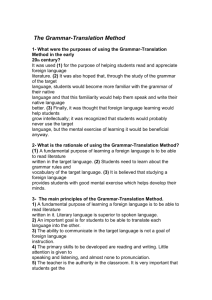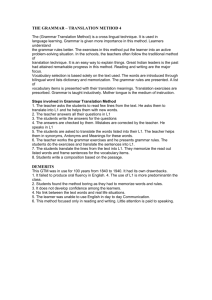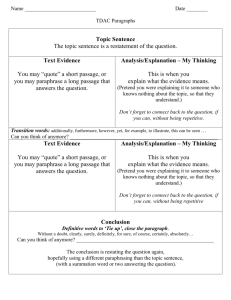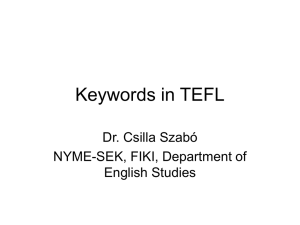lecture 2 to 3
advertisement
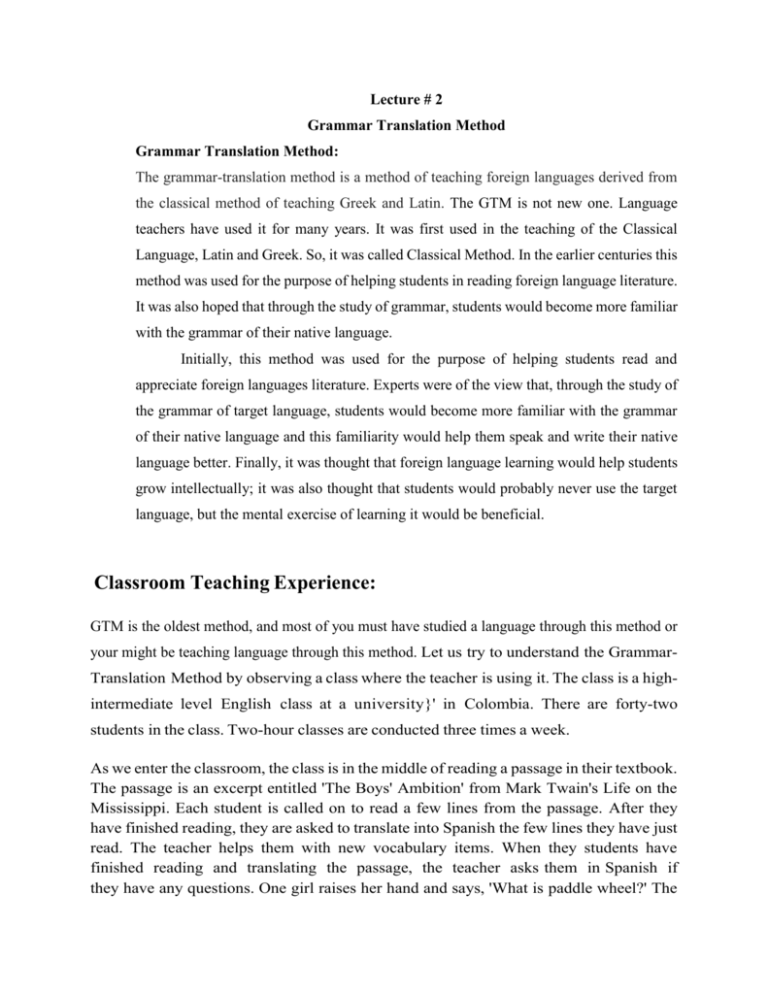
Lecture # 2 Grammar Translation Method Grammar Translation Method: The grammar-translation method is a method of teaching foreign languages derived from the classical method of teaching Greek and Latin. The GTM is not new one. Language teachers have used it for many years. It was first used in the teaching of the Classical Language, Latin and Greek. So, it was called Classical Method. In the earlier centuries this method was used for the purpose of helping students in reading foreign language literature. It was also hoped that through the study of grammar, students would become more familiar with the grammar of their native language. Initially, this method was used for the purpose of helping students read and appreciate foreign languages literature. Experts were of the view that, through the study of the grammar of target language, students would become more familiar with the grammar of their native language and this familiarity would help them speak and write their native language better. Finally, it was thought that foreign language learning would help students grow intellectually; it was also thought that students would probably never use the target language, but the mental exercise of learning it would be beneficial. Classroom Teaching Experience: GTM is the oldest method, and most of you must have studied a language through this method or your might be teaching language through this method. Let us try to understand the GrammarTranslation Method by observing a class where the teacher is using it. The class is a highintermediate level English class at a university}' in Colombia. There are forty-two students in the class. Two-hour classes are conducted three times a week. As we enter the classroom, the class is in the middle of reading a passage in their textbook. The passage is an excerpt entitled 'The Boys' Ambition' from Mark Twain's Life on the Mississippi. Each student is called on to read a few lines from the passage. After they have finished reading, they are asked to translate into Spanish the few lines they have just read. The teacher helps them with new vocabulary items. When they students have finished reading and translating the passage, the teacher asks them in Spanish if they have any questions. One girl raises her hand and says, 'What is paddle wheel?' The teacher replies, 'Es una rued a de paletas.' Then she continues in Spanish to explain how it looked and worked on the steamboats which moved up <lnd down the Mississippi River during Mark Twain's childhood. Another student says, 'No understand "gorgeous."' The teacher translates, 'Primoroso’ Since, the students have no more questions, the teacher asks them to write the answers to the comprehension questions which appears at the end of the excerpt. The questions arc in English, and the students are instructed to write the answers to them in English as well. They do the first one together as an example. A student reads out loud, 'When did Mark Twain live?' Another student replies, 'Mark Twain lived from 1835 to 1910.' 'Bueno,' says the teacher, and the students begin working quietly by themselves. In addition to questions that ask for information contained within the reading passage, the students answer two other types of questions. For the first type, they have to make inferences based on their understanding of the passage. For example, one question is: 'Do you think the boy was ambitious? Why or why not?' The other type of question requires the students to relate the passage to their own experience. For example, one of the questions based on this excerpt asks them, 'Have yon ever thought about running away from home?' After one-half hour, the teacher, speaking in Spanish, asks the students to stop and check their work. One by one each student reads a question and then reads his or her response. If it is correct, the teacher calls on another student to read the next question. If the answer is incorrect, the teacher selects a different student to supply the correct answer, or the teacher herself gives the right answer. Announcing the next activity, the teacher asks the students to turn the page in their text. There is a list of words there. The introduction to the exercise tells the students that these are words taken from the passage they have just read. The students see the words ‘ambition,' 'career,' _ 'wharf,' 'tranquil,' 'gorgeous,' 'loathe,' 'envy,' and 'humbly.' They are told that some of these are review words and that others are new to them. The students are instructed to give the Spanish word for each of them. This exercise the class does together. If no one knows the Spanish equivalent, the teacher gives it. lu Part 2 of this exercise, the students are given English words like 'love,' 'noisy,' 'ugly,' and 'proudly,' and are directed to find the opposites of these words in the passage. When they have finished this exercise, the teacher reminds them that English words that look like Spanish words are called 'cognates.' The English '-ty,' she says for example, often corresponds to the Spanish end n s. -dad and -tad. She calls the students' attention to the word 'possibly m the passage and tells them that this word is the same as the Spanish. (Read the remaininig part of experience from your book.) Following are the principles of GTM: The basic purpose of learning a foreign language is to be able to read its literature. Literary language is superior to spoken language. Students’ study of the foreign culture is limited to its literature and fine arts. An important goal is for students to be able to translate each language into the other. If students are capable enough to translate target language into native language, they are successful language learners. Communicative competence is not the goal of foreign language learning through this method. Reading and Writing Skills are to be developed; little attention is given to speaking and listening, and almost none to pronunciation. The teacher is the authority in the classroom. It is very important that teacher provides the correct answer to the students. It is possible to find native language equivalents for all target language words. Learning is enhanced when we find similarities between the target and the native language. It is important for students to learn about the form of the target language. Deductive application of an explicit grammar rule is a useful pedagogical techniques. Language learning provides good mental exercise. Students should be conscious of the grammatical rules of the target language. Verb conjugations and other grammatical paradigms should be committed to memory. Lecture # 3 Reviewing the Principles: 1: What are the goal of teachers who use Grammar-Translation Method? Teachers use GTM in the class so that students will be able to read literature written in the target language. This can be achieved by making students learn about grammar rules and vocabulary of the target language. In addition, it is believed that studying a foreign language provides students with good mental exercise which helps develop their minds. 2: What is the role of the teacher and the students in GTM? The roles are very traditional. The teacher enjoys full authority in the class and the students do whatever the teacher says. Since teacher is authority in the class so the student learn whatever the teacher teaches them. Students’ information depends on the teacher’s input; they only know what the teacher teaches them in the class. 3: What are some of the characteristics of the teaching Learning process? Students are taught to translate from one language to another. Often what they translate are readings in the target language about some aspects of the culture of the foreign language community. Students study grammar deductively; that is, they are given the grammar rules and examples, are told to memorize them, and then are asked to apply the rules to other examples. Students also learn grammatical paradigms such as verb conjugations. They memorize native language equivalents for foreign language vocabulary words. 4: What is the nature of student-teacher and student-student interaction? Most of the interaction in the classroom is from teacher to the students. There is hardly any interaction among students in the class. Teacher asks questions and the concerned student responds. 5: How are the feelings of students dealt with? There is no principle of this method that deals with the feelings of students, so students’ emotional feelings are not taken care of. 6: How is language viewed and culture viewed? Literary language is considered superior to spoken language and is therefore the language student study. Culture is viewed as consisting of literature and the fine arts. 7: What areas of language and skills are emphasized? Vocabulary and grammar are emphasized. Reading and writing are primary skills that the students work on and the oral skills (listening and speaking) are not given any attention. 8: What is the role of the students’ native language? The meaning of the target language is made clear by translating it into the students’ native language. The language that is used in class is mostly the students’ native language. The native language of the learners has been given due importance for learning the target language. GTM believes that learning a foreign language is impossible without using the native language in the class. 9: How is evaluation accomplished? In the written exams, students are directed to translate from the native language to the target language or the vice versa are often used. Questions about the foreign culture or questions that ask students to apply grammar rules are also common. 10: How does the teacher respond to student errors? Students need to know the correct answers. If students make mistakes or errors or they don’t know answers, teacher supplies them with the correct answer. Reviewing the Techniques: Following are some of the techniques associated with Grammar Translation method. Translation of a Literary Passage Students translate a reading passage form the target language into their native language. The reading passage then provides the focus for several classes: vocabulary and grammatical structures in the passage are studied in subsequent lessons. The passage is generally excerpted from some work from the target language literature, or a teacher may write a passage carefully designed to include particular grammar rules and vocabulary. The translation may be written or spoken or both. The students should not translate idioms literally, but rather in a way that shows that they understand their meaning. Reading Comprehension Questions: Students answer questions in the target language based on their understanding of the reading passage. Often the questions are sequenced so that the first group of question asks for information contained within the reading passage. In order to answer the second group of questions, students will have to make inferences based on their understanding of the passage. This means they will have to answer questions about the passage even though the answers are not contained in the passage itself. The third group of questions requires students to relate the passage to their own experience. Antonyms/Synonyms: Students are given a list of words and are asked to find antonyms in the reading passage. A Similar exercise could be done by asking students to find synonyms for a particular set of words. Or students might be asked to define a set of words based on their understanding of them as they occur in the reading passage. Cognates: Definition: A word that is related in origin to another word, such as English brother and German Bruder. Cognates within the same language are called doublets. Students are taught to recognize cognates by learning the spelling or sound patterns that correspond between the languages. When you're learning a new language, a cognate is an easy word to remember because it looks and means the same thing as a word you already know. For example, gratitude in English means the same as gratitud in Spanish. Just as words that are cognates have a shared origin — like gratitude and gratitud both coming from the Latin word gratitudo, meaning "thankfulness" — people can be cognates based on their shared blood. For example, you and your sister are cognates of your parents. You probably even look alike, just like word cognates. The adjective form of cognate can describe blood relations or anyone whose ancestors spoke the same language. Deductive Application of Rule: Grammar rules are presented with examples. Exceptions to each rule are also noted. Once students understand a rule, they are asked to apply it to some different examples. Fill-in-the Blanks Students are given a series of sentences with words missing. They fill in the blanks with new vocabulary items or a particular grammar type, such as prepositions or verbs with different tenses. Memorization Students are given lists of target language vocabulary words and their native language equivalents and are asked to memorize them. Students are also required to memorize grammatical rules and grammatical paradigms such as verbs conjugations. Use Words in Sentences: In order to show that students understand the meaning and use of a new vocabulary item, they make up sentences in which they use the new words. Composition: The teacher gives the students a topic to write about in the target language. The topic is based upon some aspects of the reading passage of the lesson. Sometimes, instead of creating a composition, students are asked to prepare a précis’ of the reading passage. Purpose of GTM: The purpose of G.T.M. was to know everything about something rather than the thing itself. According to Stern (1983) “The first language is maintained as the reference system in the acquisition of the second language.” Characteristics of GTM: 1. In Grammar Translation Method the structure of the foreign language are taught by comparing and contrasting with those of the mother tongue. 2. Reading and writing are the major focus; little or no systematic attention is paid to listening or speaking. 3. Vocabulary selection is based solely on the reading text used, and words are taught through bilingual word lists, dictionary study, and memorization. Vocabulary terms are presented with their translation equivalents, and translation exercises are prescribed. 4. More stress is on the sentence structure, because the sentence is the basic unit of teaching and language practice. According to Howatt (1984:131) “The central feature was the replacement of the traditional texts by example factory sentence.” 5. As the students are taught each and everything by translating in the mother tongue, so the teachers raise their expectations high about the students. Howatt (1984:132) “ The high priority attached to meticulous standard of accuracy which, as well as having an intrinsic moral value, was a pre-requisite for passing the increasing number of formal written examination that grew up during the century.” 6. GTM is the deductive way of teaching a language, means that language is taught trough rules rather than use. 7. The student’s native language is the medium of instruction. New items are explained by comparing and contrasting with those of native tongue and target language. 8. GTM is a very easy method. It proceeds from known to unknown. As a child already known his mother tongue and now he learns the equivalents in the target language. 9. As the difficult and lengthy definitions are avoided in GTM the vocabulary is acquired economically and effectively. Students can easily get the exact meaning of the words. 10. The teacher feels at ease while teaching through GTM because they need not to labor for preparing their lesson and to find out new ways for explaining the words. They also need to collect different A.V. aids for the preparation of their lesson. 11. In GTM at the early stages the teacher can easily evaluate the students by asking questions in their native language. Disadvantages of Grammar Translation Method: 1. In GTM much attention is not paid to oral activities or drill work, throughout the class the students are focused on reading and writing. Nothing type of conversational session is held. 2. The students become use to of thinking everything in their native language first instead of the target language. 3. It becomes much difficult to translation each and every thing in the native language or in the target language for e.g. the idiomatic expressions cannot be translated exactly. 4. GTM teaches the language by rules rather than by use. 5. Teaching through GTM makes students passive listeners because they are not motivated to speak in the class, most of the time the teacher be the active person in the class. 6. As no A.V. aids are used in GTM to make lesson interesting, so it seems very dull and boring




